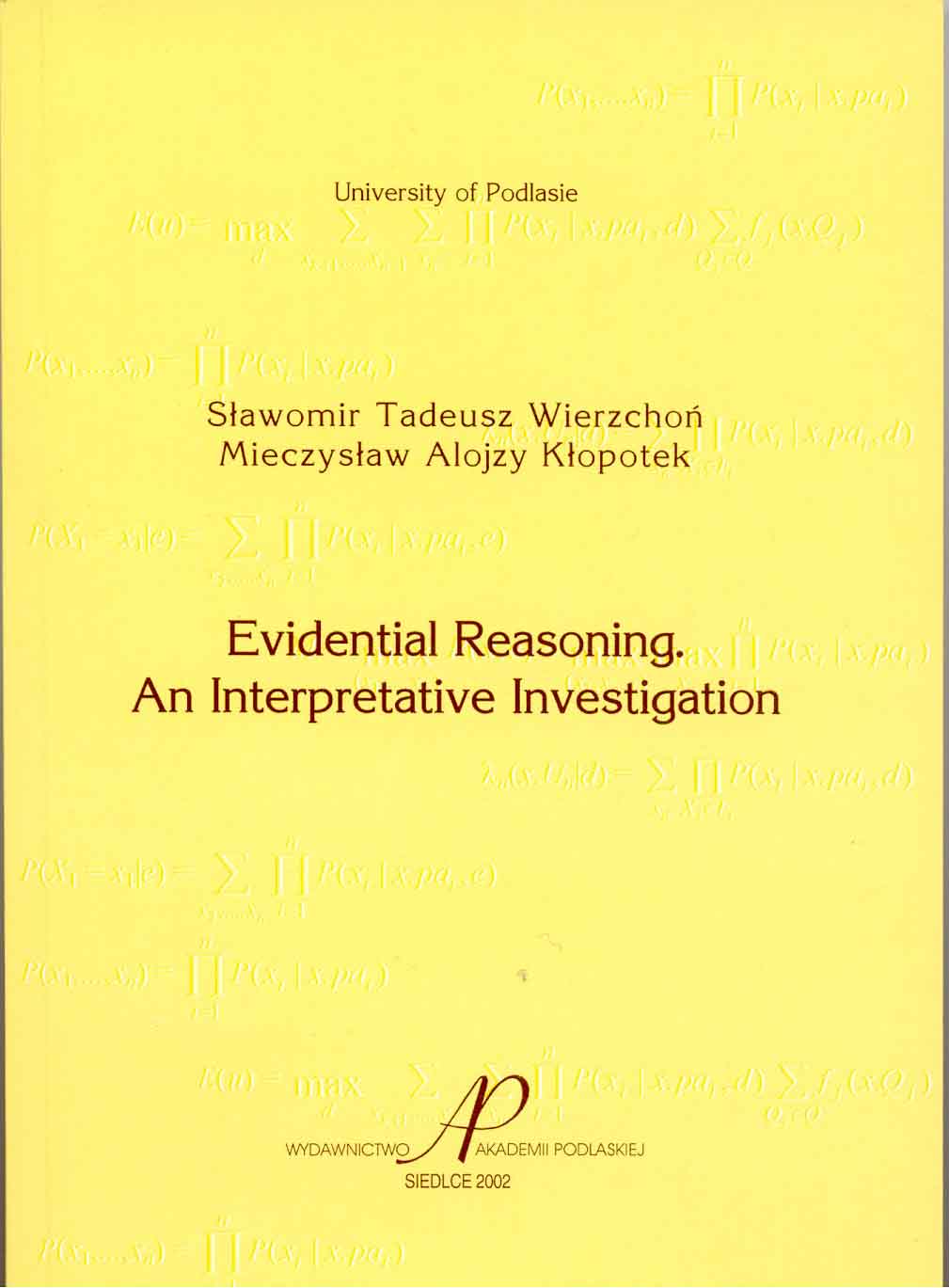Evidential Reasoning. An Interpretative Investigation.
Sławomir T. Wierzchoń and Mieczysław A. Kłopotek
published by
Wydawnictwo Akademii Podlaskiej,
wydawnictwo@ap.siedlce.pl,
Siedlce, January 2002, PL ISSN 0860-2719, 304 pages, 40 figs, price: 39.40 PLN
The book can be bought directly in the Publishing House
or ordered from the Publishing House (sent by surface mail)
 Sławomir T. Wierzchoń, D.Eng.habil., received Ph.D. in mathematical modeling of imprecise systems (1980) from Technical University of Warsaw, Dr. Sc. (Dr. Eng. habil.) from the Polish Academy of Sciences in 1997. His fields of interest include managing uncertainty in knowledge-based systems, Bayesian networks, Dempster- Shafer's theory of evidence, fuzzy sets and their application, genetic algorithms and artificial immune systems. Currently he is Associate Professor in the Institute of Computer Science Polish Academy of Sciences; also Extraordinary Professor and head of the Information Systems and Computer Networks Department at the Białystok University of Technology. S.T. Wierzchoń acted as a consultant in many projects for the industry and software firms. Further he headed university research projects and participated in national and international research projects. He is an author and co-author of more than 100 papers published in international journals, proceedings of the international conferences or as book chapters. He published also two monographs devoted to managing uncertain information and artificial immune systems.
Sławomir T. Wierzchoń, D.Eng.habil., received Ph.D. in mathematical modeling of imprecise systems (1980) from Technical University of Warsaw, Dr. Sc. (Dr. Eng. habil.) from the Polish Academy of Sciences in 1997. His fields of interest include managing uncertainty in knowledge-based systems, Bayesian networks, Dempster- Shafer's theory of evidence, fuzzy sets and their application, genetic algorithms and artificial immune systems. Currently he is Associate Professor in the Institute of Computer Science Polish Academy of Sciences; also Extraordinary Professor and head of the Information Systems and Computer Networks Department at the Białystok University of Technology. S.T. Wierzchoń acted as a consultant in many projects for the industry and software firms. Further he headed university research projects and participated in national and international research projects. He is an author and co-author of more than 100 papers published in international journals, proceedings of the international conferences or as book chapters. He published also two monographs devoted to managing uncertain information and artificial immune systems.
Mailing address:
- Instytut Podstaw Informatyki PAN, ul. Ordona 21, 01-237 Warszawa
or
- Instytut Informatyki, Politechnika. Białostocka, ul. Wiejska 45A, 15-351 Białystok
- stw@ipipan.waw.pl

Mieczysław A. Kłopotek, D.Eng.habil., received M.Sc. in 1983 and Ph.D. in computer science in 1984 from Dresden University of Technology, Germany. Dr.Sc. (Dr.Eng.habil.) from the Polish Academy of Sciences in 1998. Currently he is Associate Professor at the Institute of Computer Science of Polish Academy of Sciences; also Extraordinary Professor and head of Artificial Intelligence Department at the University of Podlasie. Author and co-author of more than 150 publications and technical expert in machine learning, data mining, pattern recognition, expert systems, reasoning under uncertainty and computer systems integration. He published two monographs on data mining with uncertain data and on intelligent search engines. M.A.Kłopotek possesses almost 20 years of experience implementing advanced Information Technology systems. He was involved in numerous consulting engagements for the industry and software firms. Furthermore, he headed university research projects and participated in national and international research projects. He is member of the Editorial Board of the International Journal Machine Graphics and Vision.
Mailing address:
- Instytut Podstaw Informatyki PAN, ul. Ordona 21, 01-237 Warszawa
or
- Instytut Informatyki, Akademia Podlaska, Sienkiewicza 51, 08-110 Siedlce
- klopotek@ipipan.waw.pl
 About this Book
About this Book
This book summarizes more than ten years of research of the Authors in the domain of evidential reasoning. To large extent it presents original contributions of the Authors in this area, including new efficient reasoning methods, learning mechanisms, sample generation mechanisms and case-based interpretation schemes applicable in the Mathematical Theory of Evidence and in its generalizations to valuation-based systems.
The book starts with a general introduction to reasoning under uncertainty and then concentrates on the evidential reasoning and its generalization to valuation-based systems. The exposition of the theoretical foundations is accompanied by explanatory examples.
This book is addressed at young researchers and students interested in advanced topics in artificial intelligence who look for still open and promising areas of research. It may be also beneficial for software engineers, in particular for knowledge engineers who look for powerful methods of representation of vague and/or incomplete knowledge as encountered in many practical applications of expert systems and other knowledge based systems.
Contents
- Preface 7
- 1. Introduction 9
- 2. Expert systems and decision analysis. An overview 13
- 2.1. Subjective versus objective probability 13
- 2.2. Assessing subjective probability 15
- 2.3. Qualitative structuring and conditional independence 17
- 2.4. Bayesian formalism 17
- 2.5. Decision theory 23
- 2.6. Early Bayesian expert systems 24
- 2.7. Knowledge-based expert systems 26
- 3. Graphical knowledge representation 31
- 3.1. Influence diagrams 31
- 3.2. Bayesian networks 32
- 3.2.1. An example of a Bayesian network 32
- 3.2.2. Independence assumption 34
- 3.3. A summary of the three main paradigms of expert systems 38
- 3.3.1. Rule-based systems 38
- 3.3.2. Neural networks 39
- 3.3.3. Bayesian networks 41
- 3.3.4. Comparing neural networks and Bayesian networks 42
- 3.3.5. Combining Bayesian networks and neural networks 43
- 3.4. Types of Bayesian networks 44
- 3.5. Modelling tricks 48
- 3.6. Applications of Bayesian networks 51
- 3.7. Other graphical representations 52
- 3.7.1. Bubble graphs 52
- 3.7.2. Markov networks 53
- 3.7.3. Chain Graphs 58
- 4. Introduction to general probabilistic reasoning 59
- 4.1. Definitions and notation 59
- 4.2. Basic queries to a Bayesian network 59
- 4.3. An elimination algorithm for belief assessment 60
- 4.4. Elimination algorithm for MPE (elim-max) 64
- 4.4.1. Backward part 64
- 4.4.2. Forward part 64
- 4.5. Elimination algorithm for MAP (elim-map) 66
- 4.6. Combining elimination and conditioning 66
- 4.7. Elimination algorithm for MEU (elim-meu) 67
- 5. Introduction \newline to the Dempster-Shafer Theory 69
- 5.1. DST versus empirical data 69
- 5.2. Some comments 72
- 5.3. Basics of the Dempster-Shafer Theory 73
- 5.4. Basics of belief function decomposition and reasoning 75
- 5.5. Valuation based systems 76
- 5.6. Computing marginals in a Markov tree 82
- 5.7. Query processing in VBS 91
- 6. Fundamental problems \newline of the Dempster-Shafer Theory 115
- 6.1. The frequency interpretation problem in DST 115
- 6.2. Problems of decomposition of belief function 124
- 6.2.1. Logical networks of Zhu and Lee 124
- 6.2.2. Directed acyclic graphs of Smets 126
- 6.2.3. Cano's et al. a-priori conditionals in directed acyclic graphs 130
- 6.2.4. Hypergraphs of Shenoy and Shafer 131
- 6.3. Testing conditional independence 132
- 6.3.1. A solution 134
- 6.3.2. Analysis of three-dimensional belief distributions 135
- 6.3.3. Some formal properties of the new measure 138
- 7. Lower/upper bound \newline interpretation 139
- 7.1. Case-based understanding of belief functions 139
- 7.2. Correct approximation of apriorical conditional belief functions 142
- 7.3. The impact on reasoning 146
- 7.4. Conclusion 148
- 8. Qualitative interpretation 149
- 8.1. The traditional interpretation in rough set theory 150
- 8.2. New interpretation 151
- 8.2.1. Conditioning as selection of a subtable 154
- 8.2.2. Combination as relational join 155
- 8.2.3. Relational marginalization and decombination 156
- 8.2.4. Multivariate beliefs and multidecision tables 158
- 8.3. Concluding remarks 161
- 9. Quantitative interpretation 163
- 9.1. Introduction 163
- 9.1.1. Instead of an informal introduction - an example 163
- 9.1.2. Formal introduction of the new interpretation 170
- 9.2. Independence and shades of conditionality 175
- 9.3. Belief from data 179
- 9.4. Independence from data 180
- 9.5. Conditional independence from data 181
- 9.6. Discussion 182
- 9.7. Formal properties of anti-conditional independence 186
- 9.7.1. Introduction 186
- 9.7.2. Cano's et al. a priori conditionals in DAGs 188
- 9.7.3. Shenoy's notion of conditionality 189
- 9.7.4. New graphoidal belief functions 192
- 9.7.5. Discussion 201
- 9.8. Conclusions 204
- 10. Knowledge acquisition from data 205
- 10.1. Introduction 206
- 10.2. Shenoy \& Shafer reasoning versus frequency interpretations 210
- 10.3. A concept of belief network 211
- 10.4. Recovery of tree-structured belief networks 215
- 10.5. Recovery of polytree-structured belief networks 217
- 10.6. Recovery of general type belief networks 218
- 10.6.1. General claims 218
- 10.7. Recovery when there are latent variables 227
- 10.7.1. Causal inference algorithm 228
- 10.7.2. From CI output to belief network 231
- 10.7.3. The new algorithm 233
- 10.7.4. Differences with the Spirtes et al. CI algorithm 239
- 10.7.5. Properties of the new algorithm 240
- 10.7.6. Experiments 247
- 10.7.7. The FCI algorithm and its correction 248
- 10.8. Discussion 252
- 10.9. Conclusions 254
- 11. Examples 255
- 11.1. The database 255
- 11.2. Measuring function and DS functions 255
- 11.3. Labeling / reasoning 259
- 11.4. Statistical independence 261
- 11.5. Belief network from data 263
- 12. Sample generation 279
- 12.1. Introduction 279
- 12.2. The problem 282
- 12.3. The Solution 282
- 12.4. Summary 290
- 13. Concluding remarks 291
- References 295
S.T.Wierzchoń ,
M.A.Klopotek
 (Created on January 12th, 2002)
(Created on January 12th, 2002)
 Sławomir T. Wierzchoń, D.Eng.habil., received Ph.D. in mathematical modeling of imprecise systems (1980) from Technical University of Warsaw, Dr. Sc. (Dr. Eng. habil.) from the Polish Academy of Sciences in 1997. His fields of interest include managing uncertainty in knowledge-based systems, Bayesian networks, Dempster- Shafer's theory of evidence, fuzzy sets and their application, genetic algorithms and artificial immune systems. Currently he is Associate Professor in the Institute of Computer Science Polish Academy of Sciences; also Extraordinary Professor and head of the Information Systems and Computer Networks Department at the Białystok University of Technology. S.T. Wierzchoń acted as a consultant in many projects for the industry and software firms. Further he headed university research projects and participated in national and international research projects. He is an author and co-author of more than 100 papers published in international journals, proceedings of the international conferences or as book chapters. He published also two monographs devoted to managing uncertain information and artificial immune systems.
Sławomir T. Wierzchoń, D.Eng.habil., received Ph.D. in mathematical modeling of imprecise systems (1980) from Technical University of Warsaw, Dr. Sc. (Dr. Eng. habil.) from the Polish Academy of Sciences in 1997. His fields of interest include managing uncertainty in knowledge-based systems, Bayesian networks, Dempster- Shafer's theory of evidence, fuzzy sets and their application, genetic algorithms and artificial immune systems. Currently he is Associate Professor in the Institute of Computer Science Polish Academy of Sciences; also Extraordinary Professor and head of the Information Systems and Computer Networks Department at the Białystok University of Technology. S.T. Wierzchoń acted as a consultant in many projects for the industry and software firms. Further he headed university research projects and participated in national and international research projects. He is an author and co-author of more than 100 papers published in international journals, proceedings of the international conferences or as book chapters. He published also two monographs devoted to managing uncertain information and artificial immune systems.

 About this Book
About this Book